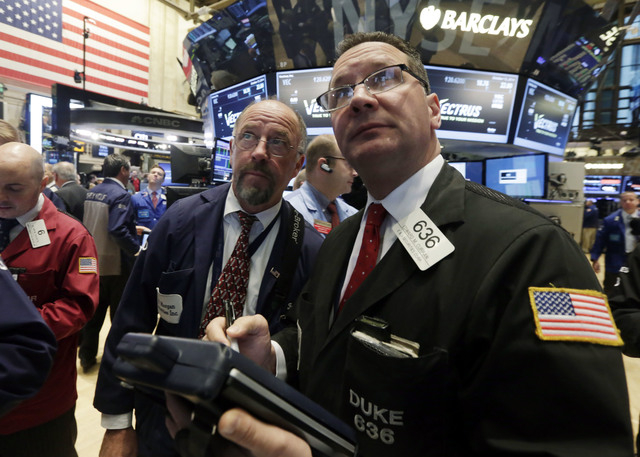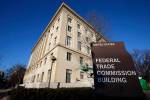Wall Street tumbles in late selling; dollar down
NEW YORK — Stocks on Wall Street tumbled in late selling on Monday as the technical picture soured for the S&P 500, while the U.S. dollar posted its worst day in a year after comments from Federal Reserve officials hinted at delays in expected interest rate hikes.
The softer dollar lifted pressure off metals prices, but Brent crude oil fell to its lowest level in almost four years after key Middle East producers signaled they would keep output high even if that meant lower prices.
Traders on Wall Street were bracing for the full onslaught of the quarterly earnings season, with many expecting the next move in equities to take its cue from corporate outlooks for the rest of the year.
Technical indicators dominated trading as the S&P 500 sank below the 1,900-point level and broke below its 200-day moving average.
“There’s been a lot of focus on breaking below certain levels,” said Rick Meckler, president of investment firm LibertyView Capital Management in Jersey City, N.J.
“Prior to earnings the market is very subject to technical, momentum trading. There’s not enough fundamental data points to grab for support,” he said.
The Dow Jones industrial average fell 223.03 points, or 1.35 percent, to 16,321.07, the S&P 500 lost 31.39 points, or 1.65 percent, to 1,874.74, and the Nasdaq Composite dropped 62.58 points, or 1.46 percent, to 4,213.66.
Shares of companies with Las Vegas ties were also affected:
— Allegiant Travel Co. fell $3.93, or 3.6 percent, to close at $105.09.
— Boyd Gaming fell 17 cents, or 1.87 percent, to close at $8.90
— Caesars Entertainment fell 55 cents, or 6.02 percent, to close at $8.59.
— Las Vegas Sands fell $1.42, or 2.35 percent, to close at $58.96.
— MGM Resorts International fell 49 cents, or 2.36 percent, to close at $20.27.
— Southwest Gas Corp. rose 22 cents, or 0.43 percent, to close at $51.63.
— Wynn Resorts Ltd. fell $3.27, or 1.85 percent, to close at $173.44.
Energy shares were among the day’s biggest losers, with the S&P energy sector down 2.9 percent. Airline shares also slid, as news of a Texas nurse who contracted Ebola while caring for a dying Liberian patient triggered worries about travel.
The S&P 500 last week posted its largest weekly decline since 2012 on continued concern about the strength of the global economy. It closed below its 200-day average for the first time since mid-November 2012.
The MSCI All-Country World index was down 0.7 percent, trading at an eight-month low. In Tokyo, Nikkei futures fell 1.6 percent.
Brazilian shares rallied 4.8 percent after market-friendly presidential candidate Aecio Neves, who will face incumbent Dilma Rousseff in a runoff vote on Oct. 26, gained momentum in election polls.
The U.S. bond market was closed for the Columbus Day holiday.
Federal Reserve officials said over the weekend that a sharp slowdown in the global economy could delay an increase in U.S. interest rates. Those remarks followed industrial data out of Germany, the euro zone’s biggest economy, that raised concerns about global growth.
“If foreign growth is weaker than anticipated, the consequences for the U.S. economy could lead the Fed to remove accommodation more slowly than otherwise,” the U.S. central bank’s vice chairman, Stanley Fischer, said.
The dollar index, which measures the greenback against a basket of currencies, was down 0.97 percent, the lowest level since October 2013. The Japanese yen gained 0.7 percent against the dollar, to 106.86, and the euro rose 1 percent to $1.2747.
“The belief is that the Fed would be one of the first central banks to tighten policy,” said Vassili Serebriakov, currency strategist at BNP Paribas in New York. “If the Fed is less likely to tighten because of global growth concerns, markets are likely to reduce their exposure to long dollar positions.”
Earlier this month, the dollar index hit its highest level since June 2010.
Spot gold prices rose with the drop in the U.S. dollar, as worries about the global economy reduced investor appetite for risk. The sharp decline in oil prices, however, kept pressure on gold in the medium term as inflation expectations have gone down.
Gold rose to a near four-week high of $1,237.30 an ounce and last stood near $1,236, up 1.1 percent. Copper gained 1 percent, the most in three weeks, bolstered by strong Chinese trade data.




























